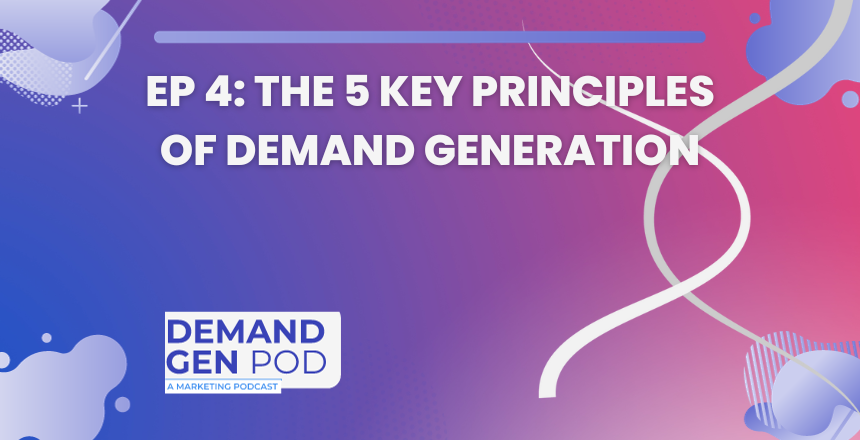Today on the Demand Gen Pod, Episode 4, Ryan, the host of the DemandGen Pod, discusses the five key principles of demand generation essential for driving awareness, generating leads, and fueling business growth. These principles include understanding the target audience, creating compelling and relevant content, implementing multi-channel marketing strategies, building a strong and engaged sales and marketing alignment, and regular performance measurement and optimization.
Ryan emphasizes the importance of knowing your audience through market research, customer data analysis, and social listening. He advises creating valuable content tailored to different stages of the buyer’s journey and stresses the need for multi-channel approaches, including social media, email marketing, SEO, and paid advertising.
Aligning sales and marketing is crucial, according to Ryan, to ensure a consistent customer experience and effective use of marketing efforts. He suggests regular communication, shared goals, and a closed-loop feedback system to achieve this alignment.
Ryan also highlights the importance of measuring performance with key metrics like lead quality and conversion rates, and the use of marketing automation tools. He shares his positive experience with a “smarketing” process from his time at Smartbear Software, which fostered collaboration between sales and marketing teams.
Emerging trends such as AI, machine learning, personalized marketing automation, augmented reality, and voice search optimization are mentioned as future considerations. Ryan concludes by encouraging businesses to adopt these principles for sustainable marketing success and invites listeners to share their experiences.
Summary notes from Episode 4:
Certainly! Below is an outline with chapters and timestamps based on the
provided transcript: ### Outline: **Chapter 1: Introduction** \- 00:01 |
Welcome and Introduction **Chapter 2: Importance of Email Template Design** \-
00:04 | Significance of Email Template Design \- 00:20 | Understanding
Audience and Email Types **Chapter 3: Types of Email Templates** \- 00:29 |
Business-Oriented vs. Marketing Style Emails \- 00:48 | Text-Based Templates
for Sales \- 01:12 | Visuals and Brand Personality **Chapter 4: Consistent
Branding** \- 01:46 | Differentiating Email Types with Branding \- 02:21 |
Leveraging Colors and Design **Chapter 5: Mobile Responsiveness** \- 02:25 |
Importance of Mobile Responsiveness \- 02:35 | Optimizing for Mobile Devices
\- 03:04 | Designing for Mobile Responsiveness **Chapter 6: Structural
Considerations for Mobile** \- 03:14 | Layout Adjustments for Mobile \- 04:44
| Handling Images and Text on Mobile Devices **Chapter 7: Font Size and
Readability** \- 05:12 | Selecting Appropriate Font Sizes \- 05:39 | Ensuring
Readability for Older Audiences **Chapter 8: Clear and Compelling CTAs** \-
06:04 | Designing Effective CTAs \- 06:48 | Testing and Optimizing CTAs
**Chapter 9: Brand Consistency** \- 07:10 | Importance of Consistent Branding
\- 07:58 | Limiting Fonts and Font Sizes **Chapter 10: Enhancing Email Design
with Visuals** \- 08:30 | Utilizing Images and Visuals \- 08:58 | Creating
Visually Appealing Emails **Chapter 11: Testing and Optimization** \- 09:12 |
Importance of Testing and Optimization \- 09:37 | Evaluating Design
Effectiveness \- 09:59 | Multiple Links to Boost Click-Through Rates **Chapter
12: Accessibility Considerations** \- 10:25 | Using Alt Text for Images and
Links **Chapter 13: Personalization and Dynamic Content** \- 11:05 |
Leveraging Personalization and Dynamic Content **Chapter 14: Conclusion** \-
11:28 | Enhancing Customer Experience and Engagement \- 11:33 | Conclusion and
Contact Information This outline captures the key topics and corresponding
timestamps discussed in the meeting.
